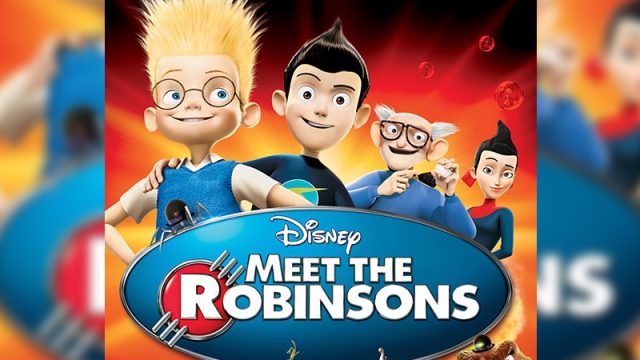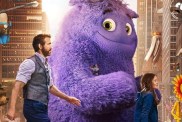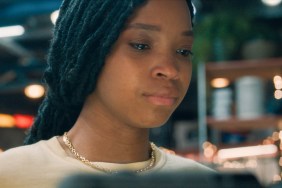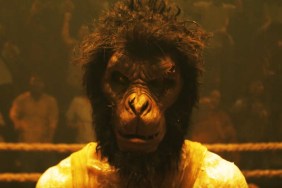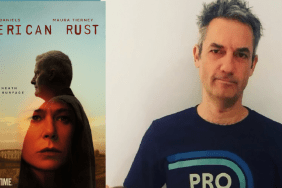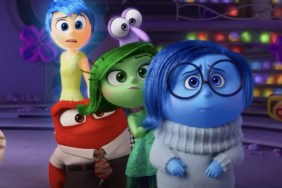Disney’s animated hit Meet the Robinsons celebrates its 15th anniversary this year. As such, ComingSoon’s Jeff Ames spoke with director Stephen J. Anderson about the film and what it means to him (and audiences) after all these years.
Per IMDB, the film tells the tale of “Boy genius Lewis. (who) gives up hope of retrieving his latest invention, which was stolen by Bowler Hat Guy, then a young time-traveler named Wilbur Robinson arrives on the scene to whisk Lewis away in his time machine. The boys spend a day in the future with Wilbur’s eccentric family and uncover an amazing secret at the same time.”
MORE: Sonic Frontiers Story Trailer Reveals Release Date
Jeff Ames: It’s been 15 years since Meet the Robinsons. For me, it feels like just yesterday that I saw it in theaters with my wife. Is that the same for you?
Stephen J. Anderson: A little bit. There are some moments where, yeah, it feels like it was just yesterday and other times where — well, a lot has happened in that 15 years. So, sometimes I feel it, sometimes I don’t. But, all good memories. That was a really special project for me.
How did you get involved with the movie and how did the story evolve over the course of the production?
I got involved around late 2002. I was just finishing up being story supervisor on Brother Bear and I had expressed interest to the studio that I would like to direct someday. So, they were keeping me in mind for things like that. Threw me a couple of things to develop on the side while I was working on Brother Bear just to kind of get my feet wet. And when I wrapped up with Brother Bear, they handed me the script for a movie called A Day With Wilbur Robinson, based off this children’s book by William Joyce, and said, “Hey, why don’t you read this and see if it’s something you want to do and eventually direct.”
I was totally taken by it. What they didn’t know when they handed it to me was that I was also adopted, so I had this instant connection — different circumstances than what Lewis went through in the movie, of course. But I had this instant connection to this kid and all those questions he was asking, like, “Where did I come from?” and “Who’s my birth mother?” I asked all those same questions when I was a kid.
So, I went back and said, “You don’t understand, I have to do this movie.” And then we were off.
When you come aboard a massive project like this, what’s day one like? Where do you even begin?
So, we grab a story team to start storyboarding and we have a small editorial team as well. Essentially what we did was all the story artists read the script and I said, “What do you think?” and we talked about it and actually went back to the studio and said, “The script’s really good, but we think if we storyboarded this as is it’s not going to work. We’d like to have permission to do a couple more rewrites and flesh it out a little bit more because we have a few more things in mind.” They said, “Yeah, go right ahead.” We did a couple more drafts of the script and started storyboarding and sort of rewrote it as we drew the storyboards. It was very fluid in terms of how the story developed.
That was day one through five, let’s say.
As you develop something like Meet the Robinsons, are you constantly questioning your vision, or is there a point where you’re satisfied with the way the production is working?
A little of both. You have to have that thing deep inside of you that’s fueling you to tell the story and impart that to everyone else on the team to fuel them enough to want to engage and be a part of this journey. But there are constantly those moments of, “Boy, I don’t know what we got here.”
Sometimes, to describe the story development process that I went through at Disney, it’s like if you’ve ever taken a word and repeated it over and over again until it doesn’t have any meaning. Suddenly it doesn’t mean what it’s supposed to mean. There are moments like that in the development of a movie where you look at it — and because animation is so iterative because you’re looking at it in all sorts of different forms, which is a good thing, but it can also lead to those moments of, “I don’t know what this is. I don’t know what I’m looking at. It’s a bunch of lines and shapes and things moving around. There’s a lot happening but I don’t have any objectivity.”
That’s what’s so great about working at a place like Disney, is you have so many fresh eyes around you. You can always find a new group of folks to look at it and give you a fresh perspective on where you can improve — what’s working, what’s not working. Other filmmakers, anybody, even if they’re not a creative person. Sometimes you just want that, you want gut reactions. Like, “I didn’t get,” or, “It wasn’t funny. Was it supposed to be funny?”
So, we’re always — I keep saying, “we,” even though I’m no longer at Disney — at Disney, that iterative process is always about getting the work in front of people and getting real honest feedback on where it’s going so then you can better make the next pass.
Animation has evolved quite a bit over the last 15 years. At the time, how complex was Meet the Robinsons? Because you’ve got dinosaurs, spaceships, numerous characters … how would the visuals change if the film were made today?
At the time it was, for Disney, a huge step forward for their computer animation. In the evolution of their computer animation technique. Up until that point, they had done Dinosaur, which was live action backgrounds with animated characters but not a fully CG world; and they had also done Chicken Little, which was a fully CG world but very cartoony — super cartoony, but in a great way. We knew we wanted to make a little more of a grounded world, a little more believable world with naturalistic lighting. We had human characters and that required all new technology for us to make the skin and hair and realistic fabric that can move and roll — all that stuff which has evolved so far today.
I think in terms of telling the story, I wouldn’t do too much other than work out a few of the story elements I think we could’ve done better, but I think if we did it today, our human animation would be at such a sophisticated level. That cartoony-ness of the some of the characters like Bowler Hat Guy, for example … I look at movies like Hotel Transylvania at Sony and the evolution of animation and how fluid and rubbery animation is now — it’s so great. We really couldn’t do that to that extent back then. We did our best. If you frame by frame some of the Bowler Hat Guy scenes you can see there’s an attempt to “break the rig,” if you will, and get some of that inorganic, non-anatomical movement or poses in there. But we were just limited to what we could do. So, I think if we did it today, the performance and the acting and the cartoony-ness would be through the roof.
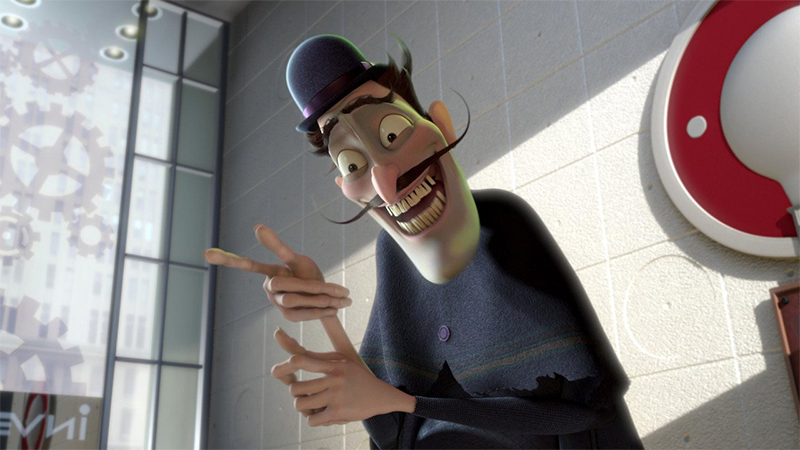
Yes, as soon as you mentioned Hotel Transylvania, I was like, Bowler Hat Guy! Because that’s exactly how he moves. So, they copied you!
[Laughs] I always thought there were two different types of animation in the movie. There was Disney animation and Looney Tunes/Warner Bros. animation. Present day characters like Lewis and little Goob and Mildred and the orphanage lady are more Disney-styled characters. They’re a little softer type of performance.
Then you get to the future and you meet the Robinsons and they’re Looney Tunes characters in the way they move and the broadness that they move. And also, their behavior — you know, they’ll grab you by the arm, invade your personal space, grab you and move you where they want you to be. They’re like those Looney Tunes characters where there aren’t any rules. They’re impulsive.
We talked about juxtaposing those things together, which was fun. So, definitely inspired by a lot of the Looney Tunes animators — Chuck Jones and Bob Clampett and those guys.
If I recall correctly, you did the voice for Bowler Hat Guy, right?
Yeah.
How did that come about, because I always felt the character had a very Jim Carrey-ish quality to him, which is one of the reasons I thought he was great.
As I’m sure you know, in animation, when you’re developing the movies, before you hire the actors, you do scratch voices. Sometimes those voices stick. Like, for Lilo and Stitch, one of the directors of the movie plays Stitch. Brad Bird, the director of The Incredibles, plays Edna. It was probably the same situation where they did the temp voice and after so many screenings of the animatic, people just started associating the voice with the character. That’s what happened with Bowler Hat Guy.
I was really honored that the studio said, “We’d like you to do it,” because we had started the casting process, but they put the brakes on that. So, yeah, there’s a little Jim Carrey in there and — gosh, I don’t even know. But, yeah, there’s definitely Jim Carrey DNA in that.
Bowler Hat Guy stole the show. Then you had the two big twists, which, for me was something I hadn’t anticipated because you don’t normally get those in an animated movie. Were those elements always part of the story?
The first script during our first couple of passes at storyboarding, Bowler Hat Guy was actually a villain named Mortimer Clinch and he was just a rival inventor of Cornelius Robinson in the future. He just wanted to go back in time and ruin Cornelius’ life because he wanted to be the success. That would have worked, but it wasn’t anything you hadn’t seen before. But then we had this roommate of Lewis’ who was just in there for fun and in one of our story meetings, one of the story artists said, “Hey, wouldn’t it be funny if they were the same person? Like, what if?” And our heads kind of exploded. We thought, “That’s pretty fun.”
We knew we had this Lewis is Cornelius reveal, but it was neat to think there could be this other shoe to drop. What ended up happening was with the Lewis/Cornelius reveal, people started figuring it out pretty quickly, but they couldn’t see the second reveal about Bowler Hat Guy coming. That one sort of threw them, which was kind of fun.
We always said, “We didn’t do that on purpose,” until everyone started telling us, “Don’t say that again, just say you did it on purpose!”
I also have to ask about Tom Selleck’s role in the movie. How did that come into play and was there a Plan B in case he wasn’t interested?
That joke, just cutting to a visual of Tom Selleck, was in there from the very beginning. One of the storyboard artists was working on that pop quiz sequence and threw that in as a joke and everyone laughed so we kept it in there. Then it was a question of whether we could get the rights to use his image, and for a while it was looking like we weren’t going to be able to. So, we thought, what if we sweeten the deal and offer him the part of Cornelius? That would be some sort of weird meta thing — Cornelius doesn’t look like him, but he sounds like him. And that worked. He came into the studio and we pitched some of the broad strokes of the movie and he thought it was funny and he said, “Yeah, I can do that!”
There was talk about having a Plan B, but none of us wanted to think about the prospect of a Plan B. The joke was so weird and funny and all of us grew up watching Magnum P.I. … I don’t know, it just seemed so right. We just crossed our fingers and hoped it would work and it did!
What did you want (or continue to want) audiences to take away from Meet the Robinsons?
Early on we liked the idea of doing a hopeful future. A lot of time, movies that deal with the future tend to bleak and horrifying. We do have some of that in the film, but I think overall, we liked the idea of something hopeful. Or, something that evoked that positive future that Walt Disney put into Epcot and Tomorrowland and all of those elements … and then when we hit on that “Keep moving forward” theme, which came from a lot of discussions about a lot our pasts — my thoughts on adoption, the original writer had a friend who had been adopted as well; and so we shared a bunch of ideas and the idea that hope comes from looking to the future not dwelling on the past. Once we figured that out, I felt that was a great, positive thing to make a movie about. I really hope that resonates with people.
Much to my sincerest joy, even today I get letters from people who tell me how that theme helped them through a tough time, or they saw the movie and that theme got them through a rough patch. As a moviemaker or artists, that’s all you can hope for.
